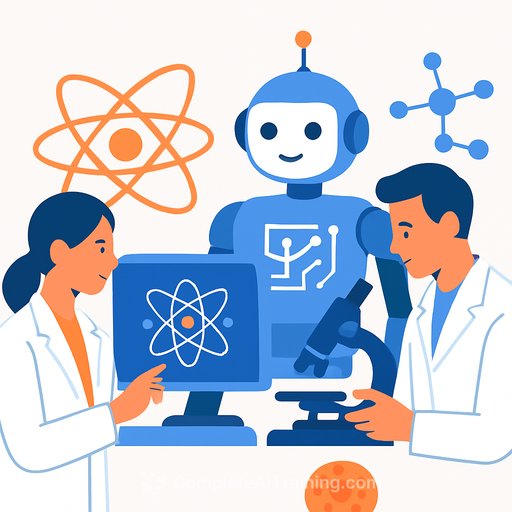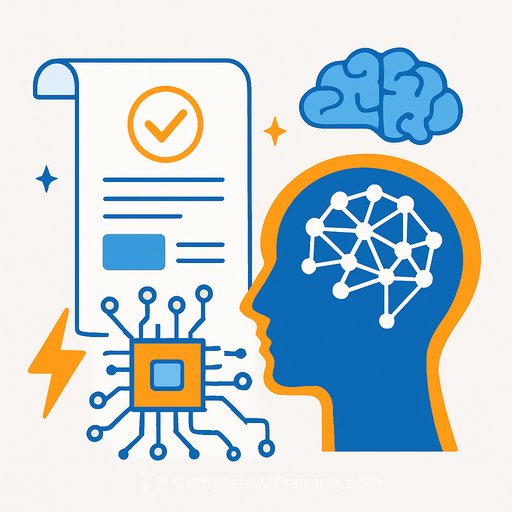AI Co-Scientists: Practical Partners for Faster, Safer Discovery
AI isn't replacing scientists. It's giving them a second brain that can read everything, connect ideas across fields, and propose what to test next. An AI co-scientist is a collaborative, multi-agent system that helps generate, review, and refine hypotheses, research proposals, and experiments-always with a human in the loop.
Built on large language models (LLMs) adapted with domain data from text and non-text sources, these systems draft hypotheses, run simulations, analyze results, and iterate. The payoff is simple: tighter feedback loops, clearer decisions, and research that's easier to reproduce.
How NVIDIA and LANL Are Building AI Co-Scientists
Los Alamos National Laboratory (LANL) and NVIDIA are developing AI agents for two hard problems: hypothesis generation for inertial confinement fusion (ICF) and molecular discovery for targeted alpha therapy (TAT). The toolchain centers on the NVIDIA NeMo framework-NeMo Curator for data preparation, NeMo 2.0 for continual pretraining and fine-tuning, and NeMo RL to teach reasoning using reinforcement learning-shaping Llama Nemotron Super 1.5 into a domain-aware model researchers can trust.
ICF Hypothesis Generation
Fusion drives the stars. On Earth, ICF attempts to achieve fusion by quickly compressing and heating a tiny fuel pellet with intense lasers. It's a tightly coupled multiphysics problem with non-linear behavior across many scales, so even small shifts in starting conditions or target design can break predictions. That gap between simulation and experiment is where AI adds real value.
LANL's approach turns a general LLM into an ICF reasoning model and then links it to simulations and experiments. The loop is straightforward:
- Curate data: Use NeMo Curator to build high-quality corpora from public sources (for example, CORE, arXiv, OSTI.gov) focused on physics and ICF.
- Adapt the model: Apply domain-adapted pretraining (DAPT) and supervised fine-tuning (SFT) on ICF content, plus reasoning-trace training.
- Benchmark: Validate with academic and custom tests, including questions written by ICF experts.
- Generate and test: Produce hypotheses, run simulations, compare to experimental data, and refine.
The goal is to improve ongoing implosion experiments at the National Ignition Facility and the OMEGA laser, reduce uncertainty, and surface designs that actually work in the lab. Outcomes here inform facility operations, deepen knowledge of extreme matter, and support national security.
Agentic AI for Cancer Treatment
Targeted alpha therapy (TAT) can be highly effective if you deliver the right radioactive atoms precisely to tumors. The challenge: designing chelators that stably bind large-radius metals like Actinium in complex biological environments. Data is sparse, and brute-force screening is slow.
LANL's agentic workflow combines an LLM with generative chemistry and simulation to search chemical space faster and with intention:
- Hypothesis generation: Llama Nemotron Super 1.5 proposes what to try next based on the problem description and prior tests.
- Molecule generation: GenMol creates candidate molecules that match the LLM's traits or scientist-specified criteria.
- Complex construction: Architector builds chelator-radioisotope complexes.
- High-fidelity modeling: LANL's NVIDIA-powered Venado system runs quantum simulations to predict key properties.
- Feedback: Results validate or reject the hypothesis, then inform the next iteration.
The team has already identified molecules with improved binding energetics for Actinium. Beyond cancer therapy, better chelators could support rapid treatment of poisoning, metal purification, and other chemical applications. Models and simulation tools are packaged as NIMs to help auto-select performance settings and keep throughput high.
What This Means for Your Lab
- Invest in data curation first. Clear corpora and well-scoped ontologies make DAPT and SFT pay off.
- Train the reasoning, not just the knowledge. Include chain-of-thought traces and domain-grounded reward models.
- Keep humans in the loop at every step-hypothesis selection, evaluation criteria, and go/no-go decisions.
- Co-locate AI agents with simulators. Tighten cycles between generation, simulation, and experiment.
- Define benchmarks early with your SMEs. Track gains with realistic tasks, not only generic leaderboards.
- Operationalize with reproducibility: version datasets, prompts, models, and simulation inputs/outputs.
"With NVIDIA, Los Alamos National Laboratory is pioneering the design and deployment of AI co-scientists in research," said Mark Chadwick, Associate Laboratory Director for Simulation, Computing, and Theory. "These co-scientists enable rapid hypothesis generation and validation across complex disciplines. We are combining domain knowledge with a combination of AI capabilities from NVIDIA to build co-scientists that are purpose-built for our mission to tackle some of humanity's grandest challenges."
Get Started
To see this work in action, meet the teams at SC25 for talks on the LANL Reasoning Model for Fusion and Agentic AI for Molecular Discovery at the NVIDIA booth. If you're building your own AI co-scientist, explore NeMo, Nemotron, and agentic workflows that integrate simulation and human review.
If your team needs structured upskilling for LLM fine-tuning, agent orchestration, and evaluation, browse targeted curricula here: AI courses by leading AI companies.
Acknowledgments
Thanks to Ping Yang, Danny Perez, Logan Augustine, Pascal Grosset, Jiyoung Lee, Thomas Summers, Michael Taylor, Radha Bahukutumbi, and David D Meyerhofer for their contributions. This research used the Perlmutter supercomputer at the National Energy Research Scientific Computing Center (NERSC), a U.S. Department of Energy Office of Science User Facility.
Your membership also unlocks:






